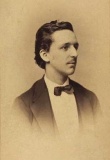Composers A-Z

Bernard Reichel
* 03.08.1901 in Neuchâtel † 10.12.1992 in Lutry
Bernard Reichel entstammt einer Familie aus Schlesien und der Provence, die sich im 19. Jahrhundert in der französischen Schweiz niederlässt. lm 1901, wird Bernard Reichel geboren. Von klein auf bekommt er eine gute Allgemeinbildung, in der die Musik einen wichtigen Platz einnimmt. lm Laufe der Jahre erkennen sowohl seine Eltern wie auch gute Lehrer seine musikalischen Begabung und Berufung.

Willi Renggli
* 03.11.1929 † 17.11.2016
No description available!

Jean Richafort
* 1480 † 1547
Jean Richafort (* um 1480; gest. 1547) war ein franko-flämischer Komponist der Renaissance.

Franz Xaver Richter
* 01.12.1709 in Holleschau (?) † 12.09.1789 in Straßburg
Franz Xaver Richter (1709-1789)
was born as the son of the soldier Matthias Richter, who was in the service of Count Franz Anton von Rottal. From 1722 to 1727 he visited the Jesuit High School of Hungarian Hradisch. Until his entry into the Hofkapelle in 1736, no biographical references are known. His further route led him across Schlitz (Fulda), Ettal and Kempten in 1769 to Strasbourg. There he took the place of the Director of Music at the Strasbourg Cathedral. Richter died on 12 September 1789 in Strasbourg.

Pedro Rimonte
* 1565 † 30.11.1627
Pedro Ruimonte (or Rimonte, Ruymonte) was a Spanish composer and musician who spent much of his career in the Low Countries.

Christa Roelcke
* 24.12.1929 in Axien † 01.07.2018 in Braunschweig
Christa Roelcke, geb. Könnecke, wurde am 24. Dezember 1929 im Pfarrhaus eines sächsischen Elbdorfes geboren. In ihrer Familie spielte seit Generationen die Musik eine zentrale Rolle. Der Vater war ein gesuchter Klavierbegleiter, die Mutter sang, und die drei Kinder wuchsen notenlesend und mehrstimmig singend auf.

Francesco Rognoni Taeggio
* 1570 in Mailand † 1626 in Mailand
Francesco Rognoni [of] Taeggio (born in Milan second half of the 16th century – died after 1626) was an Italian composer.

Joseph Röösli
* 05.09.1935 in Schüpfheim (Kanton Luzern) † 12.03.2018
Born in Schüpfheim (Canton of Luzern). His schooling over, he learnt French in Neuchâtel from 1951-1952. From 1952-1957 he attended teachers’ training college in Hitzkirch (Canton of Luzern). 1957-1960: teacher, choir conductor and organist in Hohenrain (Canton of Luzern), 1960-1962: exerted the same activities in Dagmersellen (Canton of Luzern).

Cipriano da Rore
† 1565 in Parma
Cyprian de Rore war ein flämischer Komponist der Renaissance.
Cyprian de Rore war von besonderer Bedeutung in der Geschichte des Madrigals. Seine Madrigale (seit 1542) stellen die erste Blütezeit dieser Kunstgattung dar und wurden wegweisend bis Claudio Monteverdi (1567-1643).
Cyprian de Rore war von besonderer Bedeutung in der Geschichte des Madrigals. Seine Madrigale (seit 1542) stellen die erste Blütezeit dieser Kunstgattung dar und wurden wegweisend bis Claudio Monteverdi (1567-1643).

Salomone Rossi
* 1570 † 1630
Salomone Rossi (* um 1570; gest. 1630) war ein italienischer Komponist des Frühbarock.
Salomone Rossi entstammte der alteingesessenen italienisch-jüdischen Familie der de Rossis (Me-Ha-Adumim), die ihre Ursprünge auf die Zeit des Exils unter Titus zurückführte. Als junger Mann machte er sich einen Namen als Violinist.
Salomone Rossi entstammte der alteingesessenen italienisch-jüdischen Familie der de Rossis (Me-Ha-Adumim), die ihre Ursprünge auf die Zeit des Exils unter Titus zurückführte. Als junger Mann machte er sich einen Namen als Violinist.

Frencesco Rovigo
* 1530 † 07.10.1597 in Mantua
Francesco Rovigo (1540/1541 October 7, 1597) was an Italian composer and organist of the late Renaissance, active in Mantua and Graz.
Nothing is known of his life prior to 1570, when he went to Venice, already 29 or 30 years old, to receive a musical education with the renowned organist and composer Claudio Merulo of the Venetian School.
Nothing is known of his life prior to 1570, when he went to Venice, already 29 or 30 years old, to receive a musical education with the renowned organist and composer Claudio Merulo of the Venetian School.

Fritz Ruch
* 1934 in St. Gallen
Fritz Ruch, 1934 in St.Gallen geboren, studierte in den Fünfzigerjahren Klavier bei Max Egger in Zürich und an der Ecole Normale de Musique in Paris, u.a. bei Alfred Cortot. Später folgten als Zusatzausbildung Orgelunterricht bei Erich Vollenwyder (Zürich) und Cembalo bei Edith Picht-Axenfeld (Freiburg i.Br.).

Filippo Ruge
* 1725 † 1767
Filippo Ruge lived from around 1725 until after 1767. Little is known about his life and education. Since 1744 he was a member of the Congregazione Santa Cecilia. This allows the conclusion that he was known during his lifetime.

Frederik (Federigo) Rung
* 14.06.1854 † 22.01.1914
Frederik (Federigo) Rung (1854-1914), the son of Henrik (Enrico, 1807-1871) wrote stage works, 2 symphonies, smaller orchestral pieces, chamber music, chorales and Lieder and made a career as a conductor.

Henrik (Enrico) Rung
* 30.03.1807 in Kopenhagen † 12.12.1871 in Kopenhagen
Henrik (Enrigo) Rung was a gifted Danish composer. He composed operas, musical comedies and songs.